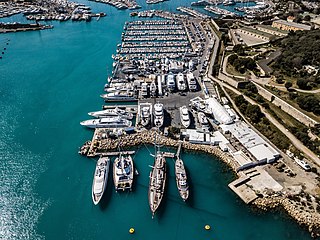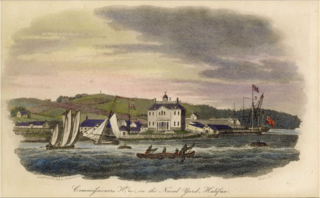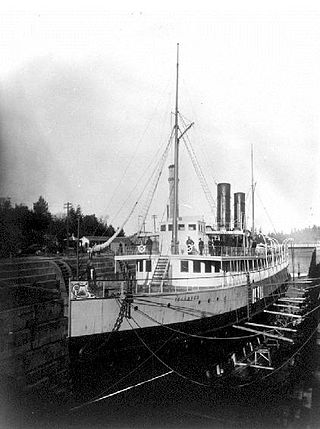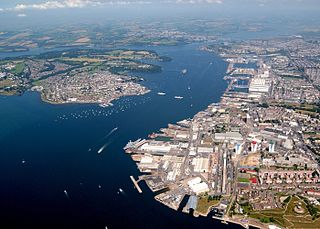
A shipyard, also called a dockyard or boatyard, is a place where ships are built and repaired. These can be yachts, military vessels, cruise liners or other cargo or passenger ships. Compared to shipyards, which are sometimes more involved with original construction, dockyards are sometimes more linked with maintenance and basing activities. The terms are routinely used interchangeably, in part because the evolution of dockyards and shipyards has often caused them to change or merge roles.

The South African Navy (SA Navy) is the naval warfare branch of the South African National Defence Force.

Royal Navy Dockyards were state-owned harbour facilities where ships of the Royal Navy were built, based, repaired and refitted. Until the mid-19th century the Royal Dockyards were the largest industrial complexes in Britain.

His Majesty's Naval Base, Portsmouth is one of three operating bases in the United Kingdom for the Royal Navy. Portsmouth Naval Base is part of the city of Portsmouth; it is located on the eastern shore of Portsmouth Harbour, north of the Solent and the Isle of Wight. For centuries it was officially known as HM Dockyard, Portsmouth: as a Royal Dockyard, Portsmouth functioned primarily as a state-owned facility for building, repairing and maintaining warships; for a time it was the largest industrial site in the world.

Simon's Town, sometimes spelled Simonstown, is a town in the Western Cape, South Africa and is home to Naval Base Simon's Town, the South African Navy's largest base. It is located on the shores of Simon's Bay in False Bay, on the eastern side of the Cape Peninsula. For more than two centuries, it has been a naval base and harbour. The town is named after Simon van der Stel, an early governor of the Cape Colony.

HMS Tamar was the name for the British Royal Navy's base in Hong Kong from 1897 to 1997. It took its name from HMS Tamar, a ship that was used as the base until replaced by buildings ashore.

Royal Naval Dockyard, Halifax was a Royal Navy base in Halifax, Nova Scotia. Established in 1759, the Halifax Yard served as the headquarters for the Royal Navy's North American Station for sixty years, starting with the Seven Years' War. The Royal Navy continued to operate the station until it was closed in 1905. The station was sold to Canada in 1907 becoming His Majesty's Canadian Dockyard, a function it still serves today as part of CFB Halifax.

Esquimalt Royal Naval Dockyard was a major British Royal Navy yard on Canada's Pacific coast from 1842 to 1905, subsequently operated by the Canadian government as HMC Dockyard Esquimalt, now part of CFB Esquimalt, to the present day.

His Majesty's Naval Base, Devonport is one of three operating bases in the United Kingdom for the Royal Navy and is the sole nuclear repair and refuelling facility for the Royal Navy. The largest naval base in Western Europe, HMNB Devonport is located in Devonport, in the west of the city of Plymouth, England.

The Commander-in-Chief South Atlantic was an operational commander of the Royal Navy from 1939. The South American area was added to his responsibilities in 1960, and the post disestablished in 1967.

HMS Durban was a Danae-class light cruiser of the Royal Navy. She was launched from the yards of Scotts Shipbuilding and Engineering Company on 29 May 1919 and commissioned on 1 November 1921.

SAS President Kruger was the first of three President-class Type 12 frigates built in the United Kingdom for the South African Navy (SAN) during the 1960s. The ship spent most of her career training and made visits to foreign ports in Africa, Western Europe and the United States. In the late 1960s, she was modernized and equipped to operate a helicopter. In the mid-1970s, President Kruger played a minor role in the South African Border War, conducting patrol operations off the Angolan coast. The ship was placed in reserve in 1977, but was recommissioned in 1980. She sank in 1982 with the loss of 16 lives after colliding with her replenishment oiler, SAS Tafelberg, in the South Atlantic.

The South African Naval Museum is a maritime museum in Simon's Town, South Africa. It contains collections and artefacts related to the maritime history of South Africa and the South African Navy.

The Port of Durban, commonly called Durban Harbour, is the largest and busiest shipping terminal in sub-Saharan Africa. It handles up to 31.4 million tons of cargo each year. It is the fourth largest container terminal in the Southern Hemisphere, handling approximately 4.5 million TEU in 2019.

SAS Somerset was a Bar-class boom defence vessel of the South African Navy, formerly preserved as a museum ship in Cape Town. It was scrapped in April 2024. Formerly HMS Barcross, it operated in Saldanha Bay, was transferred to South Africa Naval Forces during World War II, and was purchased by South Africa in 1947.
Tschukundu and Indlovu are tugboats, built in South Africa by Farocean Marine to a design from Dutch shipbuilders the Damen Group. The tug's design was based on the Damen Stan Tug 2006. The vessels have special bows for handling the South African Navy's submarines. They were delivered in February 2006 to their homeport of Simonstown.

The Selborne Graving Dock is a dry dock in Simon's Town, South Africa. It is situated within the Naval Base Simon's Town. It is named for William Palmer, 2nd Earl of Selborne, the High Commissioner for Southern Africa at the time of construction.
Naval Base Durban in Durban harbour is a naval base of the South African Navy, situated on Salisbury Island, which is now joined to the mainland through land reclamation.
Salisbury Island is located inside the Port of Durban on the east coast of South Africa; it is a former island until the Second World War when construction of a naval base connected it to the mainland by a causeway. The island, then a mangrove-covered sandbank, was named after HMS Salisbury, the Royal Navy ship that surveyed the future harbour area for the newly established Port Natal Colony in the 1820s.






















